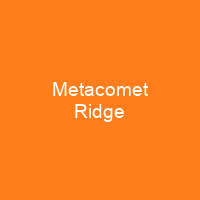The Metacomet Ridge: A Geological Marvel in Southern New England
Imagine a narrow, steep mountain ridge stretching like an ancient spine from Connecticut to Massachusetts—this is the Metacomet Ridge! How could such a rugged landscape have formed? The answer lies deep within Earth’s history, where continental rifting processes 200 million years ago created this unique geological formation. The Metacomet Ridge, composed of volcanic basalt and sedimentary rock, rises dramatically from the lower valley elevations, offering breathtaking vistas and diverse ecosystems.
Geological Wonders
As we explore the Metacomet Ridge, one cannot help but marvel at its distinctive geology. The ridge features a layer-cake structure, with the bottom layer composed of arkose sandstone, the middle layer of volcanic traprock, and the top layer of sedimentary conglomerate known as Mount Toby Conglomerate. This formation is not just a geological curiosity; it’s a living testament to Earth’s dynamic processes.
Formation and Erosion
The Metacomet Ridge was formed due to the rifting of continents during the Triassic and Jurassic periods, with basalt flows hundreds of feet thick creating the basalt crest. Erosion and deposition played a crucial role in shaping this landscape, depositing layers of sediment between lava flows that eventually lithified into sedimentary rock layers within the basalt. The resulting ‘layer cake’ structure faulted and tilted upward, exposing the basalt sheets with distinct linear ridges and dramatic cliff faces.
Ecological Diversity
The Metacomet Ridge is more than just a geological marvel; it’s an ecological wonderland. Diverse ecosystems thrive here, including oak savannas, eastern red-cedar forests, and talus slopes supporting rare plant species. The ridge also serves as a seasonal raptor migration corridor and provides municipalities with public drinking water from reservoirs located on various peaks within the range.
Cultural Significance
For thousands of years, Native American tribes have occupied this land, using traprock to make tools, hunting game, and farming in the surrounding river bottoms. Their spiritual beliefs were deeply intertwined with natural features, which later influenced regional colonial folklore. Notable stories feature a giant stone spirit named Hobbomock, who is credited with diverting the course of the Connecticut River and slaying a human-eating beaver.
Historical and Modern Impact
The Metacomet Ridge has seen significant changes over time. European settlers began settling the river valleys around the ridge in the mid-17th century, leading to deforestation for agriculture, timber harvesting, and charcoal production. Industrialization further denuded the ridges as riverways were dammed for power generation, and traprock was quarried for paving stones and architectural brownstone.
The philosophical, artistic, and environmental movement of transcendentalism transformed the Metacomet Ridge from a commercial resource to a recreational resource. Hotels, parks, and summer estates were built on the mountains from the mid-1880s to the early 20th century. Today, over 20 local non-profit organizations have become involved in conservation efforts, with international and national organizations also showing interest.
Current Challenges
The Metacomet Ridge faces significant challenges from encroaching suburban sprawl and quarry operations, which have obliterated several square miles of traprock ridgeline. Conservation efforts through public open space acquisition, land donations, conservation easements, and legislation agreements are underway to protect the ridge.

The Metacomet Ridge is a testament to the enduring beauty and ecological importance of our natural landscapes. As we continue to face challenges from urbanization and development, it’s crucial that we protect these precious resources for future generations.
You want to know more about Metacomet Ridge?
This page is based on the article Metacomet Ridge published in Wikipedia (retrieved on December 9, 2024) and was automatically summarized using artificial intelligence.







